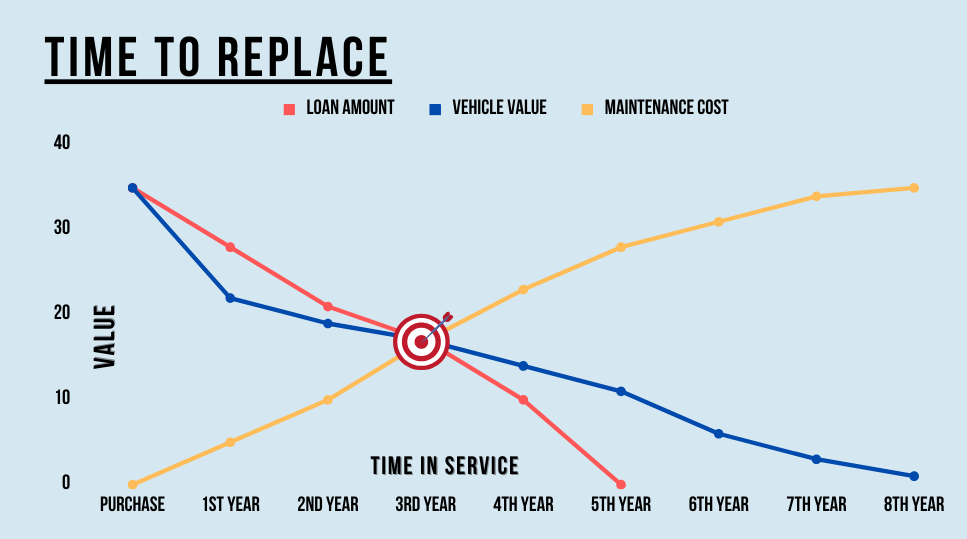OPTIMIZING YOUR FLEET Finding the Perfect Match for Your Fleet Vehicles
To progress forward, it's crucial to gauge your current position. Evaluating your existing fleet vehicles is a necessary step before embarking on the search for replacements. Consider these pivotal inquiries:
- Do you swap out vehicles based on a set age or mileage, or keep them going until they're well past their prime?
- Is there any remaining value in your traded-in vehicles?
- Do you diligently track individual maintenance expenses or take a collective approach?
- What's your strategy once you acquire ownership of fleet vehicles?
While it might appear logical to utilize your fleet vehicles until they can't function any longer, these vehicles mean much more than mere transportation for business managers and owners. They embody your company's identity and foundation, influencing both your reputation and operational capacity. Essentially, they prepare you for the roles you aspire to, not just the ones you currently fulfill. For most businesses, vehicles are revenue enablers, serving as transportation for staff/equipment to ongoing projects and also doubling as promotional tools to attract new contracts. Irrespective of your fleet's composition, whether it includes sports cars, vans, tractors, or a mixture of these, understanding when to cease pouring funds into repairs and instead opt for replacements is imperative.
EVOLUTION OF FLEET AGING
Over the past couple of decades, the average age of fleet vehicles in the United States, before being sold or exchanged, has consistently increased. Advances in comfort and engine design have prolonged their lifespan. In 2000, the mean age was 8 years, growing to 9.5 in 2008, 11 in 2015, and 13 by the end of 2019.
While this prolonged lifespan can lead to cost savings by extending purchasing cycles, it can also result in complacency. Over time, this might lead to a net loss for your enterprise. A recalibration is vital, striking the right balance between profitability and longevity.
Prioritizing safety is of paramount importance. Sharing the road with the public demands the utmost attention. Mere tire replacements won't suffice; regular comprehensive inspections are critical, particularly for older and extensively used vehicles.
Drivers play a pivotal role in safety; they should perform quick pre-use inspections and promptly communicate any concerns to fleet managers. If a vehicle raises safety alarms, it should be taken off the road for an immediate assessment.
IS IT VIABLE?
Initial higher costs often make business managers and owners reluctant to procure new vehicles. However, at times, the financially prudent choice is to part ways with aging vehicles and invest in new ones. When repair costs and downtime exceed or are on the brink of surpassing the payment for a new vehicle, it's wise to halt repairs and contemplate a replacement.
To ascertain if repair expenses are surpassing the cost of a new vehicle, delve into historical repair records and estimate future repair costs based on vehicle type and age. Then, compare the expenses of keeping the vehicle operational to the cost of acquiring a new one. Often, you'll realize that it's a "gain" rather than an "expenditure" to upgrade.
ADDITIONAL CONSIDERATIONS: Your aging fleet vehicles might accumulate concealed expenses, potentially casting your business in an unfavorable light. Customers might turn to your competitors if your fleet lacks well-maintained, polished vehicles. Initial impressions can significantly impact your bottom line.
OPTIMAL STRATEGIES FOR SUPERIOR FLEET PERFORMANCE
Step 1
Establish mileage and age thresholds for your vehicles.
Step 2
Synchronize warranty duration with time and mileage.
Step 3
Structure loan terms and payoff to align with usage patterns.
Step 4
Preemptively order replacement units to minimize delays.
"WHAT'S THE IDEAL VEHICLE LIFESPAN?"
Determining the optimal period for owning a vehicle hinges on three key factors: "Vehicle Value," "Loan Amount," and "Maintenance Cost." Vehicle value drops immediately after purchase and takes several years to match or exceed the remaining loan balance. As vehicles age, repair frequency and cost increase. On average, an optimal window appears to be around 3 years of ownership before contemplating a trade-in. Tailor this decision to the wear and tear specific to your industry when deciding when to upgrade vehicles.

"HOW DOES PROPER LOAN/VALUE/WARRANTY ALIGNMENT ASSIST?"
Selecting the right vehicle entails meticulous consideration of the vehicle loan, value (both to you and in resale), and the warranty.
By collaborating closely with your Preferred Fleet Vendor, you ensure optimal value for the right cost. A well-suited warranty package can mitigate unforeseen repair expenses and align with your usage requirements and financial plan. Experts in the Fleet and Commercial sector can aid in maximizing eligible tax incentives, further enhancing your investment.
By spending wisely, you can reinvest in your business. Fresh vehicles with a polished appearance leave a lasting impression on clients and minimize disruptions arising from unforeseen equipment malfunctions. Your new vehicles enhance your company's image as contemporary and professional, in sync with prevailing business trends.
Employee contentment and efficiency are also influenced by the vehicles they operate. Catering to their needs and providing well-equipped, comfortable vehicles can boost their productivity and overall contentment.
"HOW DOES A HEALTHY FLEET LEAD TO SATISFIED EMPLOYEES?"
Your employees essentially inhabit the vehicles you provide. Creating an environment of comfort and consideration can amplify their dedication and happiness.
Foster open communication beyond safety matters and welcome employee input. Offering incentives can drive consistent high performance. Deliberate rewards for punctuality, resourcefulness, and adherence to safety protocols. An engaging contest or the opportunity to have their name on a new vehicle can revitalize their commitment to quality and professionalism, benefiting all parties involved. It's a mutually beneficial relationship: you listen to them, and we listen to you.

